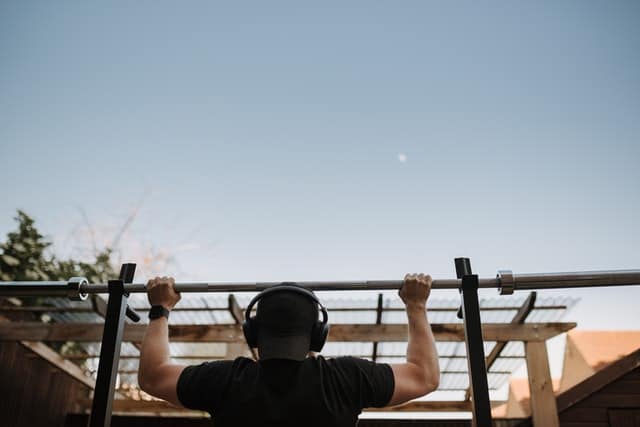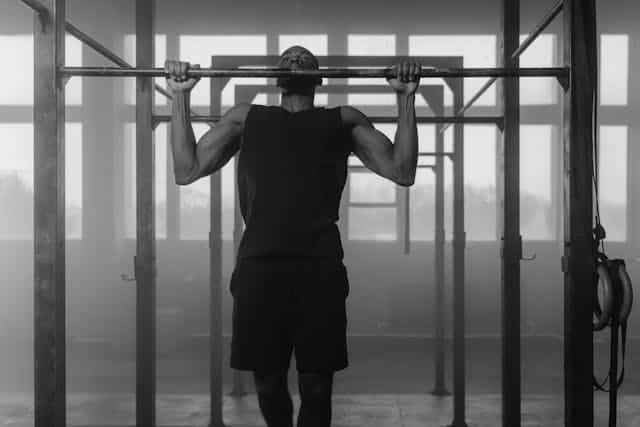Inverted Rows, Pull-ups, or Chinups: Which Should You Do?
Upper body strength is crucial for achieving overall fitness, and exercises like inverted rows, pull-ups, and chin-ups are essential for developing a strong, muscular back.
Each of these exercises has unique benefits, and even Arnold Schwarzenegger swore by pull-ups and chin-ups to build his impressive V-shaped back.
While all these upper-body exercises are excellent, one might be more suitable than the others depending on your current physical condition and various other factors.
Read below to explore the differences between these pulling exercises to help you decide which is best for your fitness goals.
Why Should You Do Pull-Ups, Chin-ups, and Inverted Rows?
Pull-ups, chin-ups, and inverted rows are the three of the best exercises for building a wide, well-developed back and big arms.
Your back comprises numerous muscles, both large and small, and a comprehensive workout routine must include a variety of exercises to effectively target these muscles.
A balanced back routine should incorporate both horizontal pulls (inverted rows or TRX rows) and vertical pulls (pull-ups or chin-ups) to ensure all muscles are adequately engaged.
Pull-ups, chin-ups, and inverted rows are functional movements that effectively work the back muscles, contributing to overall strength, improved posture, and muscle balance.
Including these exercises in your workout routine helps you achieve the coveted V-shaped physique by targeting muscles from different angles.
- Horizontal Pulls (Inverted Rows and TRX Rows): These exercises primarily target the middle back muscles, such as the rhomboids and trapezius, and are essential for developing a thick, muscular back.
- Vertical Pulls (Pull-Ups and Chin-Ups): These exercises focus on the lats and upper back, contributing to back width and overall upper body strength.
Including a variety of pulling exercises in your routine not only enhances muscle development but also helps prevent muscle imbalances, particularly for those who engage in a lot of pressing exercises like bench pressing.
Together, these exercises work nearly all the muscles in your back, aiding in the development of an aesthetic and functional physique.
Inverted Rows
Inverted rows are a fundamental bodyweight exercise that effectively targets the upper back, biceps, and forearms.
Known for their versatility and accessibility, inverted rows can be easily adjusted to accommodate different fitness levels.
This exercise is also an excellent starting point for beginners and a valuable addition to any advanced athlete’s workout routine.
What Are Inverted Rows?
Inverted rows are an excellent bodyweight exercise that targets the upper back, biceps, and forearms.
They are performed by lying underneath a bar, gripping it with both hands and pulling your chest towards the bar.
This horizontal pulling movement is effective for building strength and muscle endurance.
Here is a video of me performing inverted rows with a yoga ball, which is a more advanced inverted row variation:
Benefits
Inverted rows are beginner-friendly and easily modifiable, making them accessible to individuals at different fitness levels.
They place less strain on the shoulders and lower back compared to vertical pulling exercises like pull-ups and chin-ups, and they promote better posture and scapular retraction, which is beneficial for overall shoulder health.
Beginners can start with their feet on the ground and keep a suitable angle to reduce the strain of the exercise, and advanced trainees can progress to having their feet on a bench or yoga ball.
How to Perform
- Set a barbell on a rack at waist height.
- Lie underneath the bar and grab it with an overhand grip, hands shoulder-width apart.
- Keep your body straight, with your legs extended and heels on the ground.
- Pull your chest towards the bar, squeezing your shoulder blades together.
- Lower yourself back to the starting position with control.
Variations
- Beginner: Bend your knees and keep your feet flat on the ground to reduce resistance.
- Advanced: Elevate your feet on a bench or stability ball to increase difficulty.
TRX Inverted Rows
TRX inverted rows are actually quite different than traditional inverted rows because instead of using a barbell to row from, you will use a TRX Suspension Cable, which makes the exercise much more difficult.
However, the good part is that you can start with easier variations where your feet are on the ground and you are nearly standing upright, and gradually work your way up to more difficult levels.
TRX inverted rows also might be better for some people because they allow your shoulders to move through a more natural range of motion, which can be beneficial for people with shoulder pain.
Due to that, the TRX row is a very helpful warm-up exercise.
Overall, by incorporating inverted rows, you can build the foundational strength needed for more challenging pulling exercises like pull-ups and chin-ups while also improving posture and overall upper body stability.
Pull-ups
Pull-ups are a staple in many strength training routines, revered for their ability to build substantial upper body strength and muscle mass.
This challenging exercise engages multiple muscle groups, primarily targeting the back and biceps, and is essential for developing a wide, muscular upper body.
Despite their difficulty, pull-ups offer unparalleled benefits and can be modified to suit various fitness levels.
From my experience, like many others, incorporating pull-ups into your workout routine can help you achieve a well-rounded, powerful physique.
What Are Pull-ups?

Pull-ups are a classic bodyweight exercise that involves gripping an overhead bar with a pronated grip (palms facing away) and pulling your body up until your chin is above the bar.
This vertical pulling motion primarily targets the latissimus dorsi, trapezius, and biceps, making it a powerful exercise for building upper body strength and muscle mass.
Benefits
Pull-ups are considered one of the best exercises for developing a wide, strong back.
They engage multiple muscle groups, including the lats, upper back, shoulders, and biceps, promoting balanced muscle development.
Pull-ups also enhance grip strength and improve overall functional fitness.
Despite their difficulty, pull-ups are a highly effective exercise for those looking to achieve a V-shaped physique.
How to Perform
- Grip an overhead bar with your hands shoulder-width apart, palms facing away.
- Hang with your arms fully extended and feet off the ground.
- Engage your core and pull your body upward, leading with your chest.
- Continue pulling until your chin is above the bar.
- Lower yourself back to the starting position with control.
Variations
- Beginner: Use resistance bands or an assisted pull-up machine to reduce resistance.
- Advanced: Add weight using a dip belt or weighted vest for increased difficulty.
Mastering pull-ups can significantly enhance your upper body strength and muscle definition, making them a valuable exercise for any fitness enthusiast.
Chin-ups

Chin-ups are a powerful upper-body exercise that effectively targets the back and biceps.
Utilizing a supinated grip (palms facing you), chin-ups emphasize the biceps more than pull-ups while still providing significant engagement for the lats and shoulders.
This makes chin-ups a versatile and accessible option for those looking to enhance their upper body strength and muscle mass.
Whether you are a beginner or an advanced athlete, chin-ups offer a balanced approach to developing a strong, muscular upper body.
Incorporating chin-ups into your fitness routine can help you achieve well-rounded upper body development and improved functional strength.
Benefits
Chin-ups are slightly easier to perform than pull-ups, making them more accessible for beginners.
They are highly effective for targeting the biceps and the upper back, providing a balanced workout for the upper body.
Chin-ups also enhance grip strength and can improve overall functional fitness.
How to Perform
- Grip an overhead bar with your hands shoulder-width apart, palms facing you.
- Hang with your arms fully extended and feet off the ground.
- Engage your core and pull your body upward, leading with your chest.
- Continue pulling until your chin is above the bar.
- Lower yourself back to the starting position with control.
Variations
- Beginner: Use resistance bands or an assisted pull-up machine to reduce resistance.
- Advanced: Add weight using a dip belt or weighted vest for increased difficulty.
Incorporating chin-ups into your workout routine can significantly enhance your upper body strength and muscle definition, especially in the biceps and upper back, making them a valuable addition to any fitness regimen.
Should You Do Inverted Rows, Pull-ups, and Chin-ups?
For my shoulders, inverted rows and pull-ups work best. However, you might find that a different combination of these exercises is best for you or that you can do all of them in different amounts!
Each exercise has unique characteristics that influence difficulty, muscle engagement, and safety.
By comparing these aspects, you can determine which exercise best suits your needs and how to incorporate them effectively into your workout routine.
Difficulty Level
The difficulty level of these exercises varies significantly, making each suitable for different fitness levels. Inverted rows are generally the easiest, as they can be modified by adjusting the angle of your body.
Pull-ups are typically the most challenging due to the vertical pulling motion and the need for significant upper-body strength.
Chin-ups fall somewhere in between, offering a slightly easier alternative to pull-ups while still providing a substantial challenge.
Muscle Engagement
Each exercise targets the muscles of the back and arms differently:
- Inverted Rows: Focus primarily on the middle back muscles (rhomboids and trapezius) and the biceps. They also engage the core and help improve posture.
- Pull-ups: Target the lats, upper back (trapezius), and biceps, with a greater emphasis on back width due to the pronated grip.
- Chin-ups: Engage the lats and biceps, with a stronger focus on the biceps due to the supinated grip. This exercise also targets the upper back muscles.
Injury Risk and Safety
Safety is crucial when performing any exercise, and understanding the injury risks can help you choose the best option for your fitness level:
- Inverted Rows: Generally have the lowest risk of injury due to the horizontal pulling motion and the ability to easily modify the difficulty. They are gentle on the shoulders and lower back.
- Pull-ups: Can pose a higher risk of shoulder and elbow strain, especially if performed with improper form. It is essential to use correct technique and avoid overtraining.
- Chin-ups: Have a moderate risk of injury, particularly to the elbows due to the supinated grip. Proper form and gradual progression are key to minimizing this risk.
By comparing these exercises in terms of difficulty, muscle engagement, and injury risk, you can make an informed decision about which exercise is best for you.
Are Inverted Rows, Pull-ups, or Chin-ups Better for You?
Deciding between inverted rows, pull-ups, and chin-ups can be challenging, as each exercise offers distinct advantages depending on your fitness level, goals, and preferences.
Selecting the right exercise is crucial for maximizing your workout’s effectiveness and achieving your desired results.
Read below to learn how to determine which exercise is best suited for you by considering various factors such as your current strength, fitness objectives, and personal enjoyment.
Based on Fitness Level
Choosing the right exercise depends largely on your current fitness level:
- Beginners: Inverted rows are the best starting point due to their lower difficulty and ease of modification. They allow you to build foundational strength and perfect your form.
- Intermediate: Chin-ups are an excellent next step, providing a greater challenge while still being more accessible than pull-ups. They also offer significant benefits for bicep and upper back development.
- Advanced: Pull-ups are ideal for those with higher levels of upper body strength. They are the most challenging but also the most effective for building a wide, muscular back.
Based on Fitness Goals
Your specific fitness goals also play a crucial role in determining which exercise to prioritize:
- Muscle Hypertrophy: If your goal is to increase muscle size, incorporating all three exercises into your routine will provide comprehensive stimulation for the back and arms.
- Strength Building: For maximum strength gains, focus on pull-ups and chin-ups, as these exercises allow for more substantial resistance and progressive overload.
- Functional Fitness: Inverted rows and TRX rows are particularly beneficial for improving functional strength and stability, making them ideal for enhancing overall fitness and athletic performance.
Based on Personal Preference
As all my experiences in the fitness world have shown me, enjoyment and adherence are key factors in maintaining a consistent workout routine.
Choose the exercise that you enjoy the most and feel comfortable performing.
If you prefer a certain exercise, you’re more likely to stick with it and achieve better results over time.
Your choice between inverted rows, pull-ups, and chin-ups should be guided by your fitness level, goals, and personal preferences.
Incorporating a variety of these exercises into your routine can provide balanced muscle development and help you achieve your fitness aspirations.
Combining Horizontal and Vertical Pulls
Incorporate both horizontal (inverted rows) and vertical pulls (pull-ups and chin-ups) into your routine to ensure balanced muscle development.
This combination targets different muscle groups and provides a well-rounded approach to upper body training.
Final Thoughts: Which Exercise is Better: Inverted Rows, Pull-ups & Chin-ups?
Inverted rows, pull-ups, and chin-ups are all outstanding exercises for building upper body strength and developing a well-defined back.
I mainly do inverted rows and pull-ups because those two exercises are the most comfortable for my shoulders.
However, each exercise offers unique benefits and can be tailored to suit different fitness levels and goals.
Additionally, one of the easiest ways to increase your ability to perform pull-ups, inverted rows, or chin-ups is to start working with Fat Gripz.
Fat Gripz can quickly increase your grip strength and make doing pull-ups, chin-ups, and inverted rows easier.
By understanding the differences between these exercises and incorporating them into your workout routine, you can achieve balanced muscle development and improved functional fitness.
Whether you’re a beginner starting with inverted rows, an intermediate lifter mastering chin-ups, or an advanced athlete challenging yourself with pull-ups, these exercises will help you build the upper body strength and muscle mass you desire.
Remember to maintain proper form, progress gradually, and choose exercises that align with your fitness goals and preferences.
Ultimately, a combination of these pulling exercises will provide the most comprehensive benefits, helping you achieve the V-shaped physique and upper body strength you’ve always dreamed of.
Stay consistent, stay motivated, and enjoy the journey to a stronger, healthier you!
This website does not provide medical advice. This website site does contain affiliate links, and purchases may earn a commission.
Read my Medical Disclaimer, Review Disclaimer, and Publishing Policies for more details. Use of this site indicates acceptance of these terms.



